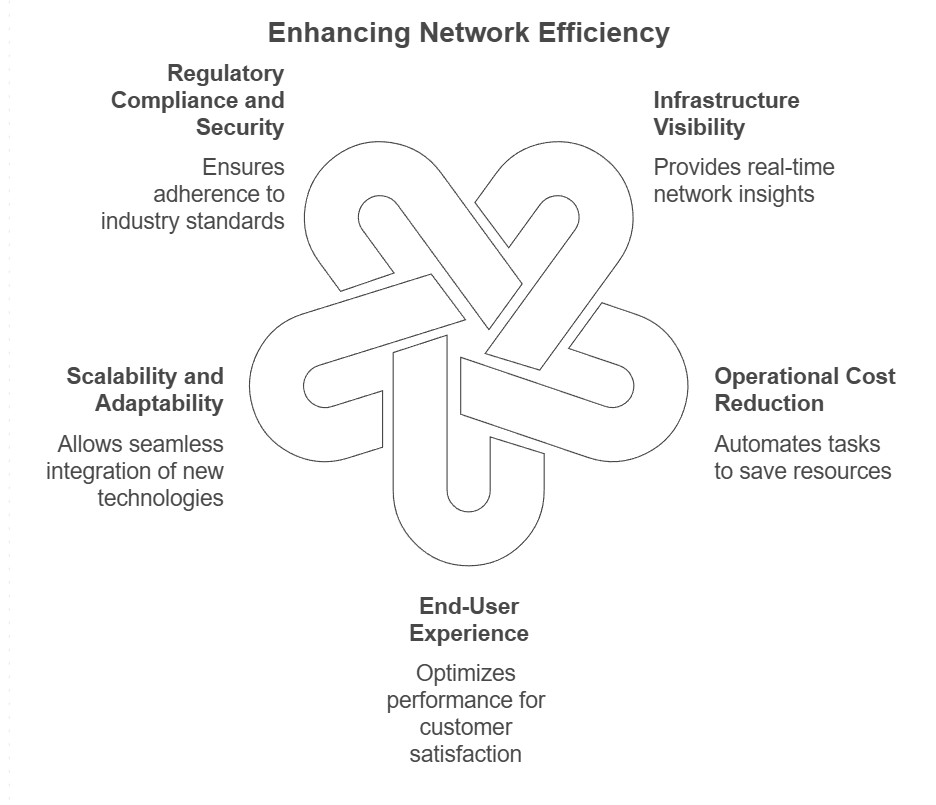
Benefits of having a telecom network management software
Table of contents
Quick Access
The telecommunications industry is the one most tied to technological changes, as it has relied on technology since its inception. A clear example is networks, which have evolved from being analog and limited in reach to now connecting us globally. That’s why network management software must be scalable and powerful.
Let's look at a case to understand this better: A few years ago, a well-known telecommunications company in Latin America faced an urgent challenge — their network was expanding rapidly, but their management tools couldn’t keep up. Technical teams worked with multiple disconnected platforms, resulting in slow response times, frequent service outages, and of course, frustrated customers.
That’s when they decided to implement centralized network management software. In less than six months, they not only improved their network availability indicators but also managed to automate critical processes, reduce operational costs, and offer a better experience to end users.
But… do you know what network management software is? Let's start with the basics and define this solution.

What is network management software?
Telecommunications network management software is a technological solution that allows you to monitor, control, and optimize all components of a network — from routers, switches, and servers to antennas, towers, and fiber optic links. These platforms centralize infrastructure monitoring, identify issues in real time, automate repetitive tasks, and offer predictive analytics for strategic decision-making.
As explained by IBM: “Network management refers to the skills, tools, and processes used to manage the overall performance of a computer network. Effective network management ensures that network resources (e.g., hardware, storage, memory, bandwidth, data, and processing power) are easily accessible to users efficiently and securely.”
Features may vary depending on the provider and the client’s needs, but in general, good management software allows for:
- Full network visibility
- Performance management (QoS)
- Fault and event management
- Remote equipment configuration
- Security and access control
- Integration with emerging technologies such as 5G and SDN (software-defined networks)
Key benefits of implementing network management software
1. Complete infrastructure visibility
One of the biggest headaches for IT teams is the lack of visibility into what’s happening in every corner of the network. Management software provides centralized dashboards with real-time maps, proactive alerts, and detailed reports that enable data-driven decisions. This significantly reduces diagnosis and incident resolution times.
2. Reduction in operational costs
By automating tasks such as equipment configuration, firmware updates, and traffic analysis, companies can operate with fewer human resources, resulting in tangible savings. Additionally, by preventing failures, costs related to service interruptions are reduced.
3. Better end-user experience
An efficient network directly translates into satisfied customers. Service outages, low speed, or network congestion have an immediate impact on brand perception. With a management solution, it's possible to optimize performance, ensure SLA compliance, and personalize the customer experience based on usage profile.
4. Scalability and adaptability to change
As a company grows or evolves technologically (e.g., migrating to 5G or integrating IoT solutions), well-designed management software allows for seamless scaling. New nodes, devices, or technologies can be added without needing to redesign the network from scratch.
5. Regulatory compliance and security
In a regulated industry like telecommunications, compliance with quality, privacy, and security standards is essential. These platforms make it easier to implement access policies, log tracking, threat detection, and incident response.

Use cases: how industry leaders apply it
Giants like AT&T, Vodafone, and Telefónica have already adopted advanced network management platforms based on artificial intelligence and machine learning. In fact, Telefónica has developed its own system called UNICA Next, which allows them to operate a fully virtualized 5G network, reducing service provisioning time from days to minutes (Telefónica Tech).
These solutions not only improve technical performance but also enable new business models, such as private 5G networks for enterprise clients — a trend growing strongly in industries like manufacturing, healthcare, and logistics.
At Rootstack, with over 15 years meeting the needs of the telecommunications industry, we have the expertise and knowledge to scale your network systems. Contact one of our advisors to start working together.
We recommend this video
Related blogs

Microservices architecture: Designing scalable systems

External threats to computer security | Rootstack

Rootstack Cybersecurity Solutions: Protection and Monitoring

Core Banking Software Platforms: Key Features to Look for in 2026

Software development services company: What could we do?
